

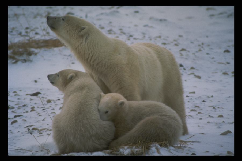

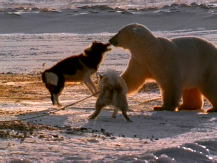

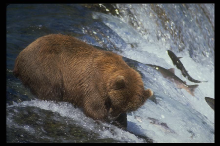
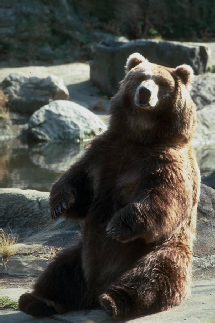

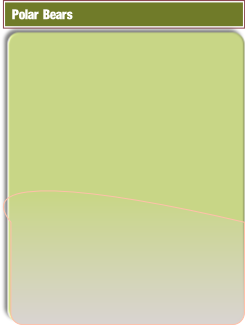




In countries across Asia, thousands of bears live a life of torture on bear farms, so that their bile can be extracted and used in traditional medicine to cure ailments ranging from headaches to hemorrhoids. Bears are confined in cages which vary from agonizingly tiny "crush" cages to larger pens, all of which cause terrible physical and mental suffering.
Scientists believe that Ursus maritimus, the "sea bear," evolved about 200,000 years ago from brown bear ancestors.
Polar bears are the world's largest land predators They top the food chain in the Arctic, where they prey primarily on seals.
Adult male polar bears weigh from 775 to more than 1,500 pounds. Females are considerably smaller, normally weighing 330 to 550 pounds.
There was a time, in scientific circles, when animals were not credited with the ability to reason and it was thought that all their actions were instinctive. The French philosopher and mathematician Rene Descartes (1596 – 1650) was unyielding in his belief that only humans possess consciousness. To defend his position about the immortal human soul he took the unshakable stand that animals were nothing more than fleshy pieces of machinery unable to think and feel anything. He could not have been more wrong. By the way, we have Descartes to thank for the horrible treatment of animals like nailing dogs to tables and dissecting them alive.
Luckily not more than 100 years later some philosophers including Voltaire and Humes wrote about animals having feelings and intelligence. And finally Charles Darwin's theories helped turn things around. People came to understand that animals (besides humans) posses intelligence even though they their brains are not as developed as human brains.
But here we run into a problem. How can we define intelligence in animal terms?
The brain size in animals started to increase about 400 million years ago and the
brain size of carnivores kept increasing. The Sun Bear has the largest absolute brain
size of any carnivore. This bear has a higher EQ and larger neo cortex relative to
rest of brain size then the gorilla. And, also, the sun bear-
Court with affection (not all mammals do this and bears are solitary)
Spank their young (actual teaching not instinct is involved)
High degree of unpredictability
strongly curious
Hiding dark nose with a paw (polar bear)
Backtracking
Hiding behind ice blocks (polar bear)
Sneaking
Bluffing
Concealing self in ambush; hiding from humans
Beginning hibernation during heavy snowfall to conceal tracks to den
Retreating in the face of great odds (human impacts)
Hiding tracks (jump to side, step on own tracks, wade in stream)
Using tools
From “The Great Bear Almanac”
iologist Gary Alt was following bear tracks for a while and then the tracks suddenly stopped. Alt looked around for rocks, water or anything that could conceal the bear's tracks but found nothing. When he went back to the bear tracks he noticed toe marks at both ends but no evidence the bear had turned around. Alt followed the tracks back and noticed then about 50 yards back the place where the bear had jumped off the main trail and left in a 90 degree angle to his old tracks. (Stephen Herrero's Bear attacks)






